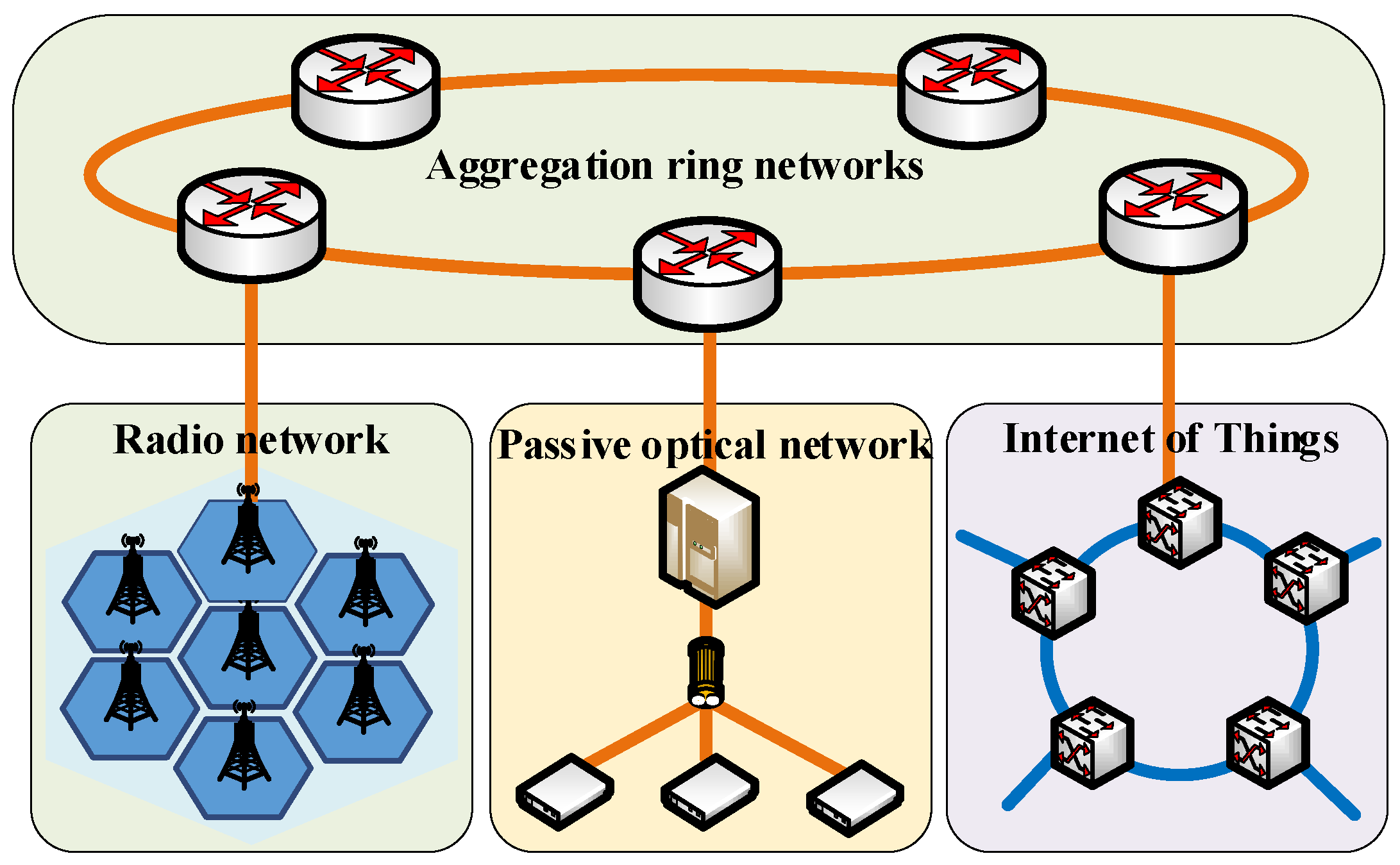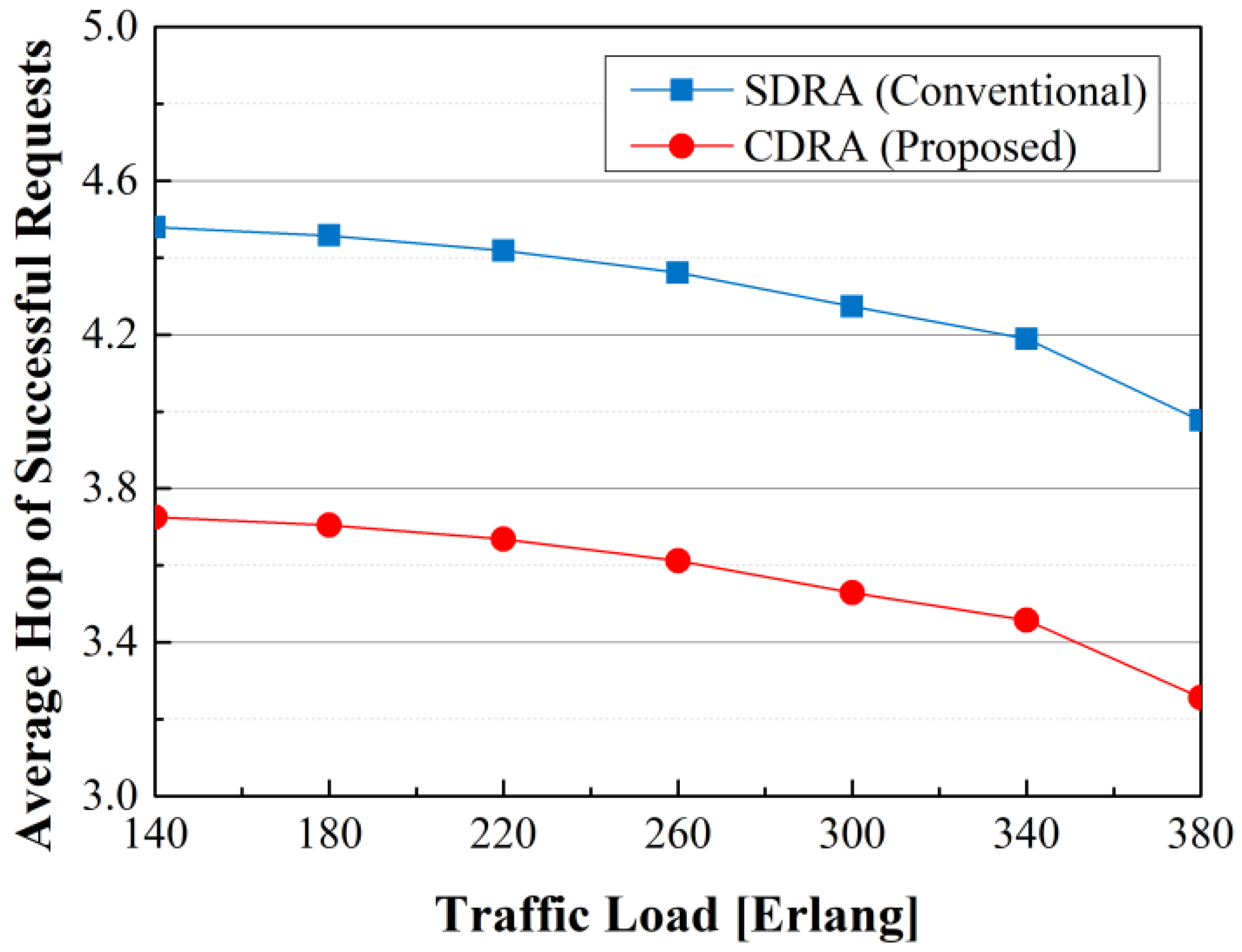Cross-Domain Resource Allocation Scheme with Unified Control Architecture in Software Defined Optical Access Network
Abstract
1. Introduction
2. Related Works
3. Unified Control Architecture with Cross-Domain Function Modules
3.1. System Model
3.2. Unified Control Architecture for Optical Access Network
3.3. Cross-Domain Function Modules
- (1)
- RC
- (2)
- OC
- (3)
- PC
3.4. Enhanced OpenFlow Protocol
4. Proposed CDRA Scheme with Interaction Process
4.1. CDRA Interaction Process
4.2. CDRA Scheme with Global Evaluation Strategy
5. Performance Evaluation with Result Analysis
5.1. Simulation Platform Testbed
5.2. Architecture Controller Verification
5.3. Performance Evaluation with Result Analysis
6. Conclusions
Author Contributions
Funding
Institutional Review Board Statement
Informed Consent Statement
Conflicts of Interest
References
- Saliou, F.; Chanclou, P.; Neto, L.A.; Simon, G.; Potet, J.; Gay, M.; Bramerie, L.; Debregeas, H. Optical access network interfaces for 5G and beyond. J. Opt. Commun. Netw. 2021, 13, D32–D42. [Google Scholar] [CrossRef]
- Bao, B.; Yang, H.; Yao, Q.; Yu, A.; Chatterjee, B.C.; Oki, E.; Zhang, J. SDFA: A service-driven fragmentation-aware resource allocation in elastic optical networks. IEEE Trans. Netw. Serv. Manag. 2021, 19, 353–365. [Google Scholar] [CrossRef]
- Alimi, I.A.; Patel, R.K.; Muga, N.J.; Pinto, A.N.; Teixeira, A.L.; Monteiro, P.P. Towards Enhanced Mobile Broadband Communications: A Tutorial on Enabling Technologies, Design Considerations, and Prospects of 5G and beyond Fixed Wireless Access Networks. Appl. Sci. 2021, 11, 10427. [Google Scholar] [CrossRef]
- Borges, R.M.; de Souza Lopes, C.H.; Lima, E.S.; de Oliveira, M.A.; Cunha, M.S.B.; Alexandre, L.C.; da Silva, L.G.; Pereira, L.A.M.; Spadoti, D.H.; Romero, M.A.; et al. Integrating Optical and Wireless Techniques towards Novel Fronthaul and Access Architectures in a 5G NR Framework. Appl. Sci. 2021, 11, 5048. [Google Scholar] [CrossRef]
- Yang, H.; Yao, Q.; Bao, B.; Yu, A.; Zhang, J.; Vasilakos, A.V. Multi-associated parameters aggregation-based routing and resources allocation in multi-core elastic optical networks. IEEE ACM Trans. Netw. 2022, 30, 2145–2157. [Google Scholar] [CrossRef]
- Afraz, N.; Slyne, F.; Gill, H.; Ruffini, M. Evolution of Access Network Sharing and Its Role in 5G Networks. Appl. Sci. 2019, 9, 4566. [Google Scholar] [CrossRef]
- Bao, B.; Yang, H.; Wan, Y.; Yao, Q.; Yu, A.; Zhang, J.; Chatterjee, B.; Oki, E. Node-Oriented Traffic Prediction and Scheduling Based on Graph Convolutional Network in Metro Optical Networks. In Proceedings of the Optical Fiber Communication Conference (OFC), San Francisco, CA, USA, 6–10 June 2021. [Google Scholar]
- Kani, J.; Terada, J.; Hatano, T.; Kim, S.; Asaka, K.; Yamada, T. Future optical access network enabled by modularization and softwarization of access and transmission functions. J. Opt. Commun. Netw. 2020, 12, D48–D56. [Google Scholar] [CrossRef]
- Wang, X.; Ji, Y.; Zhang, J.; Bai, L.; Zhang, M. Low-Latency Oriented Network Planning for MEC-Enabled WDM-PON Based Fiber-Wireless Access Networks. IEEE Access 2019, 7, 183383–183395. [Google Scholar] [CrossRef]
- Yang, H.; Bao, B.; Li, C.; Yao, Q.; Yu, A.; Zhang, J.; Ji, Y. Blockchain-enabled Tripartite Anonymous Identification Trusted Service Provisioning in Industrial IoT. IEEE Internet Things 2021, 9, 2419–2431. [Google Scholar] [CrossRef]
- Kretsis, A.; Sartzetakis, I.; Soumplis, P.; Mitropoulou, K.; Kokkinos, P.; Nicopolitidis, P.; Papadimitriou, G.; Varvarigos, E. ARMONIA: A Unified Access and Metro Network Architecture. Appl. Sci. 2020, 10, 8318. [Google Scholar] [CrossRef]
- Ai, Y.; Qiu, G.; Liu, C.; Sun, Y. Joint resource allocation and admission control in sliced fog radio access networks. China Commun. 2020, 17, 14–30. [Google Scholar] [CrossRef]
- Koyasako, Y.; Suzuki, T.; Yamada, T.; Shimada, T.; Yoshida, T. Demonstration of Real-Time Motion Control Method for Access Edge Computing in PONs. IEEE Access 2022, 10, 168–175. [Google Scholar] [CrossRef]
- Msongaleli, D.L.; Kucuk, K.; Kavak, A. Adaptive Polling Medium Access Control Protocol for Optic Wireless Networks. Appl. Sci. 2019, 9, 1071. [Google Scholar] [CrossRef]
- Sun, S.; Yan, H.; Maccartney, G.R.; Rappaport, T. Millimeter wave small-scale spatial statistics in an urban microcell scenario. In Proceedings of the International Conference on Communications (ICC), Paris, France, 21–25 May 2017. [Google Scholar]
- Song, Z.; Ji, W.; Yin, R.; Li, J.; Gong, Z.; Yun, H. Highly Reliable Metro-Access Network Based on a Dual-Fiber Ring Architecture and Optimized Protection Mechanisms. IEEE Access 2021, 9, 136419–136437. [Google Scholar] [CrossRef]
- Yang, S.; He, N.; Li, F.; Trajanovski, S.; Chen, X.; Wang, Y.; Fu, X. Survivable Task Allocation in Cloud Radio Access Networks with Mobile-Edge Computing. IEEE Internet Things 2021, 8, 1095–1108. [Google Scholar] [CrossRef]
- Han, X.; Meng, X.; Kang, Q.; Su, Y. Survivable Virtual Network Link Shared Protection Method Based on Maximum Spanning Tree. IEEE Access 2019, 7, 92137–92150. [Google Scholar] [CrossRef]
- Alvizu, R.; Maier, G.; Kukreja, N.; Pattavina, A.; Morro, R.; Capello, A.; Cavazzoni, C. Comprehensive survey on T-SDN: Software-defined networking for transport networks. IEEE Commun. Surv. Tutor. 2017, 19, 2232–2283. [Google Scholar] [CrossRef]
- Kalkan, K.; Zeadally, S. Securing Internet of Things (IoT) with software defined networking (SDN). IEEE Commun. Mag. 2017, 56, 186–192. [Google Scholar] [CrossRef]
- Fondo-Ferreiro, P.; Mhiri, S.; López-Bravo, C.; González-Castaño, F.J.; Gil-Castiñeira, F. Fast Decision Algorithms for Efficient Access Point Assignment in SDN-Controlled Wireless Access Networks. IEEE Trans. Netw. Serv. Manag. 2019, 16, 1059–1070. [Google Scholar] [CrossRef]
- Coronado, E.; Khan, S.N.; Riggio, R. 5G-EmPOWER: A Software-Defined Networking Platform for 5G Radio Access Networks. IEEE Trans. Netw. Serv. Manag. 2019, 16, 715–728. [Google Scholar] [CrossRef]
- Rahimi, P.; Chrysostomou, C.; Pervaiz, H.; Vassiliou, V.; Ni, Q. Joint Radio Resource Allocation and Beamforming Optimization for Industrial Internet of Things in Software-Defined Networking-Based Virtual Fog-Radio Access Network 5G-and-Beyond Wireless Environments. IEEE Trans. Ind. Inform. 2022, 18, 4198–4209. [Google Scholar] [CrossRef]
- Ejaz, W.; Sharma, S.K.; Saadat, S.; Naeem, M.; Anpalagan, A.; Chughtai, N.A. A comprehensive survey on resource allocation for CRAN in 5G and beyond networks. J. Netw. Comput. Appl. 2020, 160, 102638. [Google Scholar] [CrossRef]
- Ma, Y.; Wang, H.; Xiong, J.; Diao, J.; Ma, D. Joint Allocation on Communication and Computing Resources for Fog Radio Access Networks. IEEE Access 2020, 8, 108310–108323. [Google Scholar] [CrossRef]
- Hossain, A.R.; Ansari, N. Priority-Based Downlink Wireless Resource Provisioning for Radio Access Network Slicing. IEEE Trans. Veh. Technol. 2021, 70, 9273–9281. [Google Scholar] [CrossRef]
- Marzouk, F.; Barraca, J.P.; Radwan, A. On Energy Efficient Resource Allocation in Shared RANs: Survey and Qualitative Analysis. IEEE Commun. Surv. Tutor. 2020, 22, 1515–1538. [Google Scholar] [CrossRef]
- Zhang, C.; Zeng, H.; Yi, X.; Xiong, R. Global load-balancing ONU assignment for a software-defined reconfigurable PON. J. Opt. Commun. Netw. 2020, 12, 177–191. [Google Scholar] [CrossRef]
- Hatem, J.A.; Dhaini, A.R.; Elbassuoni, S. Deep Learning-Based Dynamic Bandwidth Allocation for Future Optical Access Networks. IEEE Access 2019, 7, 97307–97318. [Google Scholar] [CrossRef]
- Zhan, N.; Gan, C.; Hui, J.; Guo, Y. Fair Resource Allocation Based on User Satisfaction in Multi-OLT Virtual Passive Optical Network. IEEE Access 2020, 8, 134707–134715. [Google Scholar] [CrossRef]
- Hadi, M.; Bhar, C.; Agrell, E. General QoS-aware scheduling procedure for passive optical networks. J. Opt. Commun. Netw. 2020, 12, 217. [Google Scholar] [CrossRef]
- Helmy, A.; Nayak, A. Centralized vs. Decentralized Bandwidth Allocation for Supporting Green Fog Integration in Next-Generation Optical Access Networks. IEEE Commun. Mag. 2020, 58, 33–39. [Google Scholar] [CrossRef]
- Thyagaturu, A.S.; Mercian, A.; McGarry, M.P.; Reisslein, M.; Kellerer, W. Software Defined Optical Networks (SDONs): A Comprehensive Survey. IEEE Commun. Surv. Tutor. 2016, 18, 2738–2786. [Google Scholar] [CrossRef]
- Han, P.; Liu, Y.; Guo, L. QoS satisfaction aware and network reconfiguration enabled resource allocation for virtual network embedding in Fiber-Wireless access network. Comput. Netw. 2018, 143, 30–48. [Google Scholar] [CrossRef]
- Mosahebfard, M.; Vardakas, J.; Ramantas, K.; Verikoukis, C. SDN/NFV-Based Network Resource Management for Converged Optical-Wireless Network Architectures. In Proceedings of the 21st International Conference on Transparent Optical Networks (ICTON), Angers, France, 9–13 July 2019. [Google Scholar]
- Giuliari, G.; Roos, D.; Wyss, M.; García-Pardo, J.A.; Legner, M.; Perrig, A. Colibri: A cooperative lightweight inter-domain bandwidth-reservation infrastructure. In Proceedings of the 17th International Conference on emerging Networking Experiments and Technologies (CoNEXT), New York, NY, USA, 12–15 December 2021. [Google Scholar]
- Liu, Q.; Lin, X.; Yue, S.; Sun, W.; Hu, W. A Routing Scheme for Bulk Data Transfers in Multi-Domain OCS Networks with Assistive Storage. In Proceedings of the IEEE International Conference on Communications (ICC), Shanghai, China, 20–24 May 2019. [Google Scholar]
- Li, X.; Ni, R.; Chen, J.; Lyu, Y.; Rong, Z.; Du, R. End-to-End Network Slicing in Radio Access Network, Transport Network and Core Network Domains. IEEE Access 2020, 8, 29525–29537. [Google Scholar] [CrossRef]
- Lagkas, T.; Klonidis, D.; Sarigiannidis, P.; Tomkos, I. Optimized Joint Allocation of Radio, Optical, and MEC Resources for the 5G and Beyond Fronthaul. IEEE Trans. Netw. Serv. Manag. 2021, 18, 4639–4653. [Google Scholar] [CrossRef]
- Yang, H.; Cui, Y.; Zhang, J. Unified Multi-Layer among Software Defined Multi-Domain Optical Networks (Invited). Electronics 2015, 4, 329–338. [Google Scholar] [CrossRef]
- Shafi, M.; Molisch, A.F.; Smith, P.J.; Haustein, T.; Zhu, P.; Silva, P.; Tufvesson, F.; Benjebbour, A. 5G: A tutorial overview of standards, trials, challenges, deployment, and practice. IEEE J. Sel. Area Commun. 2017, 35, 1201–1221. [Google Scholar] [CrossRef]
- Bao, B.; Xu, Z.; Li, C.; Sun, Z.; Liu, S.; Li, Y. TDTS: Three-Dimensional Traffic Scheduling in Optical Fronthaul Networks with Conv-LSTM. Photonics 2021, 8, 451. [Google Scholar] [CrossRef]
- Zhao, L.; Hu, W.; Zhang, X. Architecture and performance of grouped ROADM rings with shared optical amplifier and grouped add/drop ports for hybrid data center network. Opt. Switch. Netw. 2017, 23, 1–4. [Google Scholar] [CrossRef]
- Yang, H.; Bai, W.; Yu, A.; Yao, Q.; Zhang, J.; Lin, Y.; Lee, Y. Bandwidth Compression Protection against Collapse in Fog-Based Wireless and Optical Networks. IEEE Access 2018, 6, 54760–54768. [Google Scholar] [CrossRef]











| Referred Works | Field | Main Features |
|---|---|---|
| [23,24,25,26,27] | Radio domain | Researching resource allocation on capacity, latency, energy, and etc., but it is lack of the consideration on optical domain in access network. |
| [28,29,30,31,32,33] | Optical domain | Researching the resource allocation of PON in terms of capacity, QoS, energy, etc., but lack of the consideration on multiple resource domains. |
| [37,38,39,40] | Radio and optical domains | SDN technology is adopted to manage the resource in multiple domains scenario, but few joint resource allocations with global resource-oriented optimization. |
| Proposed in this paper | SDN technology is also adopted to support cross-domain interaction, and a cross-domain resource allocation is proposed with a global evaluation strategy considering the traffic situation of each node. |
Publisher’s Note: MDPI stays neutral with regard to jurisdictional claims in published maps and institutional affiliations. |
© 2022 by the authors. Licensee MDPI, Basel, Switzerland. This article is an open access article distributed under the terms and conditions of the Creative Commons Attribution (CC BY) license (https://creativecommons.org/licenses/by/4.0/).
Share and Cite
Bao, B.; Yao, Q.; Li, C.; Sun, Z.; Li, X.; Bai, W.; Yang, H.; Liu, S.; Li, Y. Cross-Domain Resource Allocation Scheme with Unified Control Architecture in Software Defined Optical Access Network. Photonics 2022, 9, 740. https://doi.org/10.3390/photonics9100740
Bao B, Yao Q, Li C, Sun Z, Li X, Bai W, Yang H, Liu S, Li Y. Cross-Domain Resource Allocation Scheme with Unified Control Architecture in Software Defined Optical Access Network. Photonics. 2022; 9(10):740. https://doi.org/10.3390/photonics9100740
Chicago/Turabian StyleBao, Bowen, Qiuyan Yao, Chao Li, Zhengjie Sun, Xiangyue Li, Wei Bai, Hui Yang, Sheng Liu, and Yunbo Li. 2022. "Cross-Domain Resource Allocation Scheme with Unified Control Architecture in Software Defined Optical Access Network" Photonics 9, no. 10: 740. https://doi.org/10.3390/photonics9100740
APA StyleBao, B., Yao, Q., Li, C., Sun, Z., Li, X., Bai, W., Yang, H., Liu, S., & Li, Y. (2022). Cross-Domain Resource Allocation Scheme with Unified Control Architecture in Software Defined Optical Access Network. Photonics, 9(10), 740. https://doi.org/10.3390/photonics9100740






